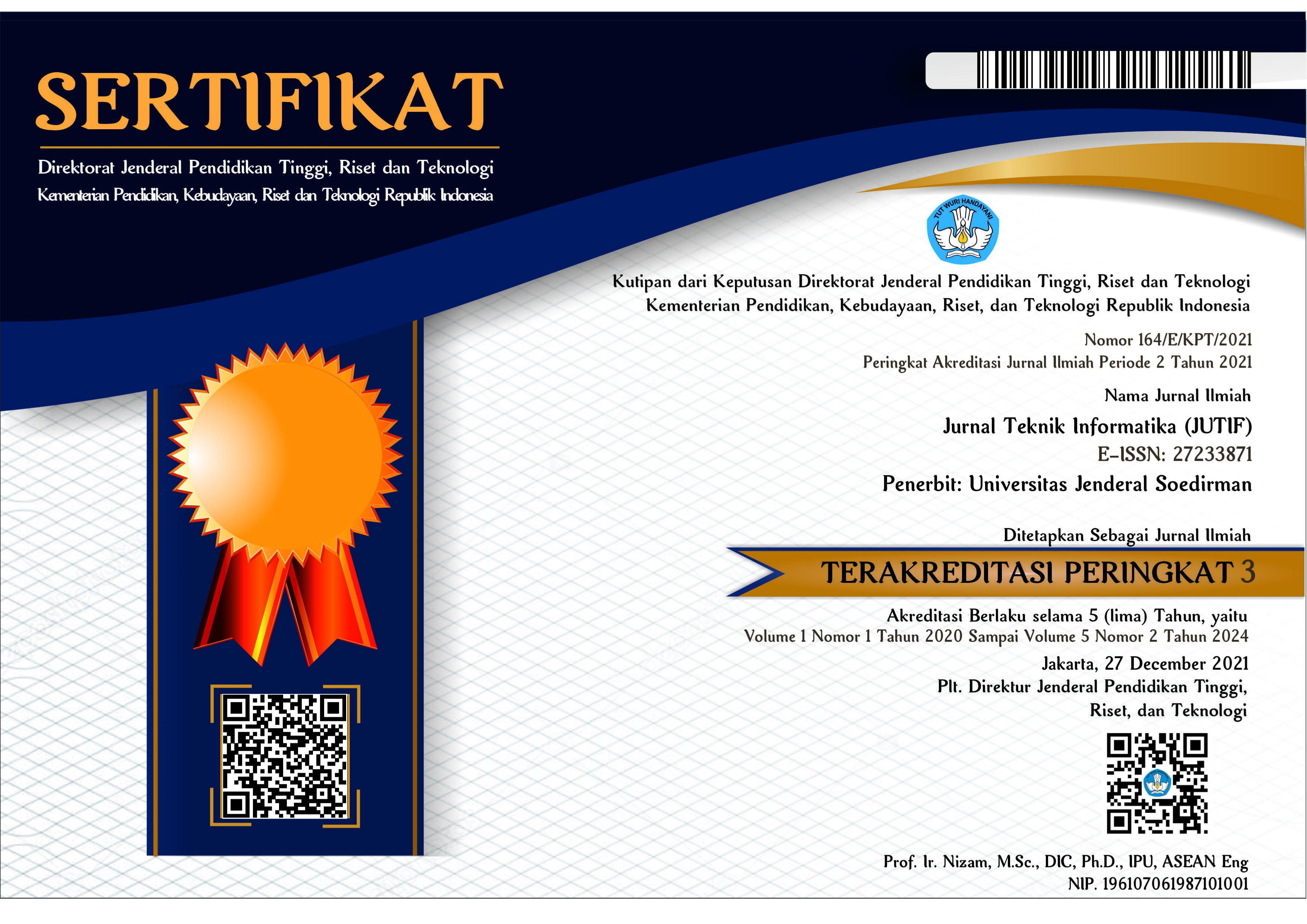IOT-BASED REMOTE LIGHT CONTROL SYSTEM USING BOT TELEGRAM APPLICATION (CASE STUDY OF SMP AL WASHLIYAH CIREBON)
DOI:
https://doi.org/10.20884/1.jutif.2022.3.6.313Keywords:
IoT, Lights Control, Smartphone, Telegram, Telegram BotAbstract
Advances in technology nowadays could make it easier for human beings in order to save time doing work that is commonly done. Smartphones are currently developing rapidly, and at the moment social media applications can be used to emerge as remote controllers which could manage electronic devices remotely. This study objectives to construct an IoT-based remote light control system using the telegram application. The consequences of this have a look at are predicted to save the user's time to turn on or turn off the lights remotely. Users only need to open the telegram application, then select the bot constructed to control the lights, and be asked to press the available commands. The consequences of this study take a look at the telegram bot application can turn the lights on and off properly, this has a delay less than 60 seconds according to the connection used, for every command that is pressed from the telegram bot utility.
Downloads
References
M. I. Mahdi, “Pengguna Media Sosial di Indonesia Capai 191 Juta pada 2022,” DataIndonesia.id, 2022. https://dataindonesia.id/digital/detail/pengguna-media-sosial-di-indonesia-capai-191-juta-pada-2022 (accessed Apr. 23, 2022).
B. Ajeng, “Jumlah Pengguna Telegram Melonjak: India dan Indonesia Penyumbang Terbesar,” uzone.id, 2021. https://uzone.id/Jumlah-Pengguna-Telegram-Melonjak-India-dan-Indonesia-Penyumbang-Terbesar (accessed Apr. 23, 2022).
M. A. Rizaty, “Pengguna Telegram Tembus 500 Juta Orang pada 2021 | Databoks,” databoks.katadata.co.id, 2022. https://databoks.katadata.co.id/datapublish/2022/02/18/pengguna-telegram-tembus-500-juta-orang-pada-2021 (accessed Apr. 23, 2022).
S. Puti, N. Pembimbing, M. Firdaus, M. S. Jurusan, I. Komunikasi -Konsentrasi, and H. Masyarakat, “Efektivitas Komunikasi Aplikasi Telegram sebagai Media Informasi Pegawai PT.POS Indonesia (PERSERO) Kota Pekanbaru,” 2018.
E. P. Nugroho, “Sistem Reporting Keamanan pada Jaringan Cloud Computing Melalui bot Telegram dengan Menggunakan Teknik Intrussion Detection and Prevention System,” J. Teknol. Terpadu, vol. 5, no. 2, pp. 49–57, 2019, doi: 10.54914/jtt.v5i2.233.
F. Z. Alfaiz and M. Maryam, “Implementation Telegram Chat Bot on Student Orientation Period Registration System for Efficiency of Data Management,” J. Tek. Inform., vol. 2, no. 2, pp. 85–93, 2021, doi: 10.20884/1.jutif.2021.2.2.56.
R. Parlika and D. S. Hutama, “Studi Komparatif Implementasi Push Message Pada Media Sosial Secara Gratis,” e-NARODROID, vol. V, no. 2, pp. 44–55, 2019.
Y. Efendi, “Internet Of Things (Iot) Sistem Pengendalian Lampu Menggunakan Raspberry Pi Berbasis Mobile,” J. Ilm. Ilmu Komput., vol. 4, no. 2, pp. 21–27, 2018, doi: 10.35329/jiik.v4i2.41.
A. Satriadi, Wahyudi, and Y. Christiyono, “Perangcangan Home Automation Berbasis NodeMcu,” Transient, vol. 8, no. 1, pp. 2685–0206, 2019, [Online]. Available: https://ejournal3.undip.ac.id/index.php/transient
Yuswandari and H. Yuana, “Rancang Bangun Sistem Kendali Jarak Jauh Lampu Menggunakan Thingsboard Berbasis IoT,” J. Inform. Polinema, vol. 7, no. 1, pp. 29–36, 2020.
Iswanto and Gandi, “Perancangan dan Implementasi Sistem Kendali Lampu Ruangan Berbasis IoT (Internet of Things) Android (Studi Kasus Universitas Nurtanio),” J. FIKI, vol. IX, no. 1, pp. 2087–2372, 2018, [Online]. Available: http://jurnal.unnur.ac.id/index.php/jurnalfiki
D. Suhardi, “PROTOTIPE CONTROLLER LAMPU PENERANGAN LED ( LIGHT EMITTING DIODE ) INDEPENDENT BERTENAGA SURYA Prototype Lamp Lighting Controller LED ( Light Emitting Diode ) Independent Solar Jika kita perhatikan cadangan energi dari bahan minyak bumi di Indonesia diper,” Jurna GAMMA, vol. 10, no. September, pp. 116–122, 2014.
A. Rosman, Risdayana, E. Yuliani, and Vovi, “Karakteristik Arus dan Tegangan Pada Rangkaian Seri dan Rangkaian Paralel dengan Menggunakan Resistor,” J. Ilm. d’Computare, vol. 9, no. 2, pp. 40–43, 2019.
M. Erfan, M. A. Maulyda, I. Ermiana, V. R. Hidayati, and T. Ratu, “Profil Kemampuan Pembedaan Rangkaian Seri Dan Paralel Calon Guru Sekolah Dasar,” Edu Sains J. Pendidik. Sains Mat., vol. 8, no. 1, pp. 13–21, 2020, doi: 10.23971/eds.v8i1.1907.
G. Hergika, Siswanto, and Sutarti, “Perancangan Internet of Things (IoT) Sebagai Kontrol Infrastuktur Dan Peralatan Toll Pada Pt. Astra Infratoll Road,” J. PROSISKO, vol. 8, no. 2, pp. 86–98, 2021, [Online]. Available: https://e-jurnal.lppmunsera.org/index.php/PROSISKO/article/view/3862
D. Aryani, I. J. Dewanto, and A. Alfiantoro, “Prototype Alat Pengantar Makanan Berbasis Arduino Mega,” Petir, vol. 12, no. 2, pp. 242–250, 2019, doi: 10.33322/petir.v12i2.540.
D. Intern, “Belajar Bahasa Pemrograman C Untuk Pemula - Dicoding Blog,” dicoding, 2021. https://www.dicoding.com/blog/belajar-pemrograman-c-pemula/ (accessed Apr. 23, 2022).
S. Kurniawan, T. Bayu, “Perancangan Sistem Aplikasi Pemesanan Makanan dan Minuman Pada Cafetaria NO Caffe di Tanjung Balai Karimun Menggunakan Bahasa Pemrograman PHP dan My.SQL,” J. TIKAR, vol. 1, no. 2, pp. 193–206, 2020.











